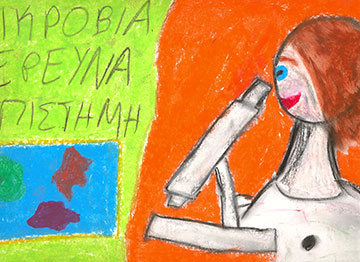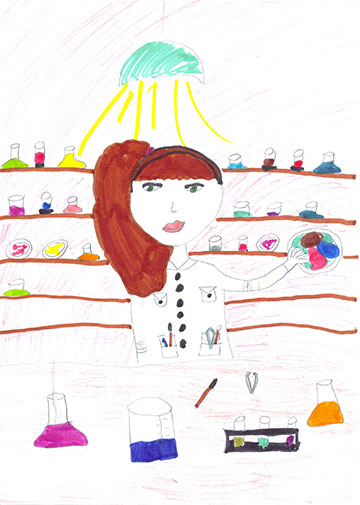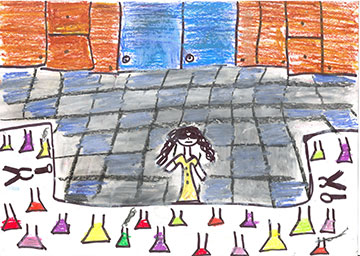
From a series of drawings by 10- and 11-year-olds in Greece. [Image: Vasilia Christidou]
Fifty years ago, had you asked a child to draw a scientist, 99 percent of the time that drawing would be of a man. But how have children’s perceptions of gender and science changed over the past five decades—and what might that mean for the future?
A meta-analysis published this past spring, spanning 78 studies across 50 years, offered hints to an answer. The study revealed that children’s depictions of scientists have become more gender diverse over time (Child Dev., doi: 10.1111/cdev.13039). But the study also found that, as children age, they are more likely to sketch men.
Drawing scientists
The so-called draw-a-scientist test has its roots in a study, published in 1983, in which a sample of 5,000 elementary school students between the years 1966 and 1977 were asked to draw a scientist. The drawings almost exclusively depicted males, often with lab coats and glasses. Only 28 students (0.6 percent, all girls) drew female scientists.
The draw-a-scientist test, which has been repeated numerous times after the original study, revealed that children held strong stereotypes linking men with science. But since 1983, the proportion of women in science in the U.S. has risen significantly. A 2016 National Science Board study found that from 1960 to 2013, the proportion of women in the U.S. scientific workforce rose from 28 percent to 49 percent in biological science, 8 percent to 35 percent in chemistry and 3 percent to 11 percent in physics and astronomy. Moreover, women are now more visible in science, with scientific textbooks, magazines and television shows depicting increased gender diversity.
Toward a more diverse picture

From a series of drawings by 10- and 11-year-olds in Greece. [Image: Vasilia Christidou]
Given this increase in representation, a research team at Northwestern University, USA, hypothesized that gender–science stereotypes should be weaker in later decades and, thus, that U.S. children should draw male scientists less often. The team also predicted that stereotypes linking men with science would strengthen with children’s age, but would weaken overall over time. To test these predictions, the team conducted a meta-analysis of U.S. draw-a-scientist studies, including 78 independent samples across a wide range of grade levels, resulting in more than 20,000 drawings from students age 5 to 18.
The researchers found that in studies between 1985 and 2016, 72 percent of the drawings depicted male scientists, compared with 99.4 percent in the 1983 study. Older children drew male scientists more often than younger children. In fact, the mean percentage of male scientist drawings did not significantly differ from 50 percent until age 8.
Interestingly, these trends were consistent when analyzing the all-female student samples separately. In the 1983 study, 98.8 percent of girls drew male scientists compared to 55 percent in later studies. The team also reports that, on average, girls drew 30 percent of scientists as male in early elementary school, but switched to drawing 75 percent of scientists as male in high school. The team concluded that historical time and age effects did not significantly differ by children’s sex.
Weakening stereotypes?

From a series of drawings by 10- and 11-year-olds in Greece. [Image: Vasilia Christidou]
The team believes that its findings provide insight into how children learn to associate science with gender and how kids respond to changes in women’s representation in science. The researchers note that while some gender associations happen as early as ages 2 to 3, such as those about gender and household chores, children did not draw significantly more male scientists until ages 7 to 8. According to the team, these results suggest that children’s science–gender stereotypes have weakened over time, mirroring changing gender roles in society.
In the future, the team believes that it would be interesting to see an international meta-analysis to investigate national differences. One limitation of the analysis was that most of the 78 studies were local sample populations and therefore not necessarily nationally representative.
The researchers point out that women in certain scientific fields, such as physics, remain underrepresented. “Children still draw more male than female scientists in recent studies,” said study co-author Alice Eagly, “but that is expected because women remain a minority in several science fields.”
Yet Eagly generally found the results encouraging for the future of women in scientific roles—and emphasized ways to keep the momentum going. “Given these results, girls today may develop interests in science more freely than before, because children's stereotypes of scientists have become less masculine over time," she noted in a press release accompanying the study. “But because stereotypes remain, teachers and parents should present children with multiple examples of female as well as male scientists across many contexts such as in science courses, on television shows, and in informal conversations.”
